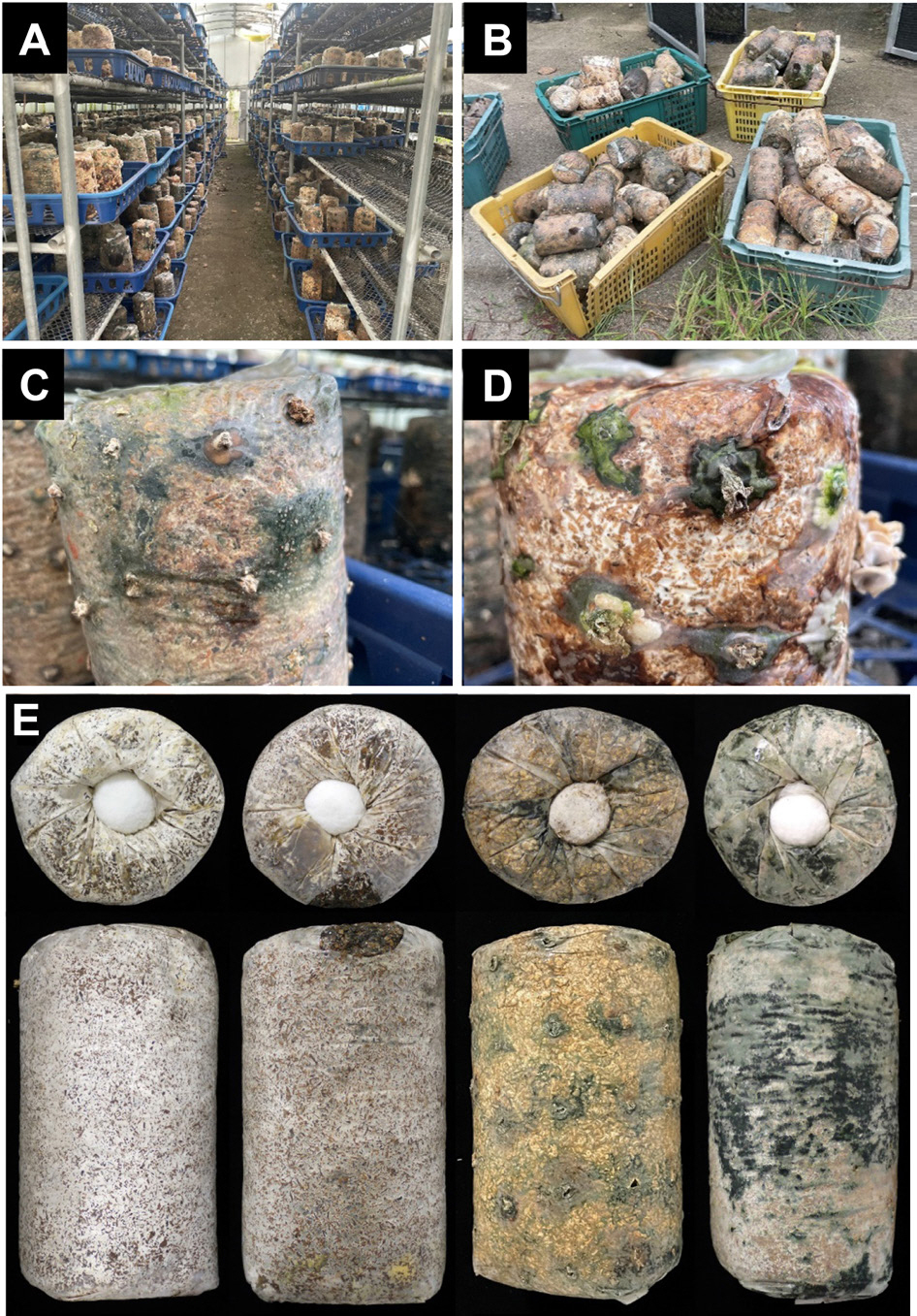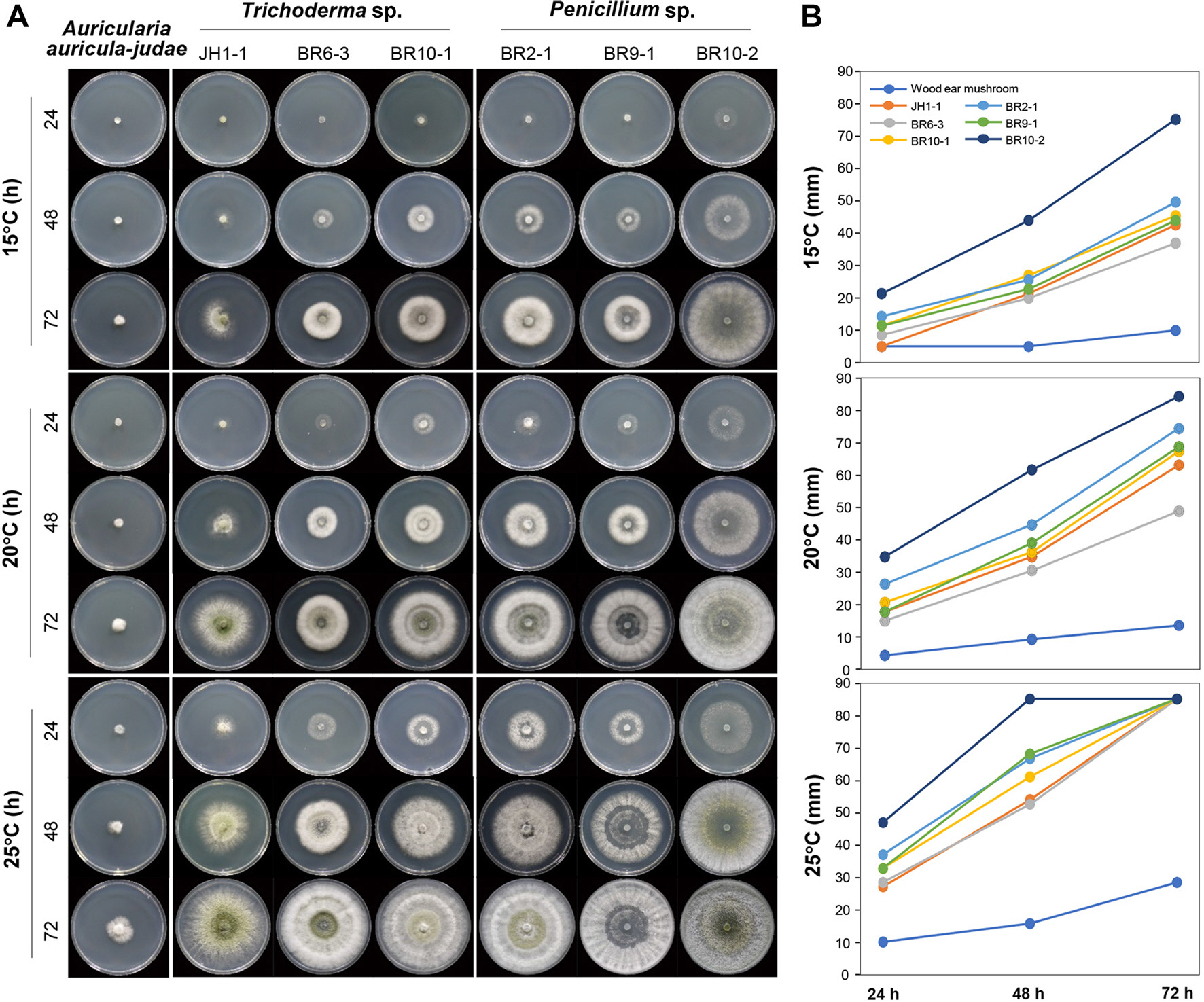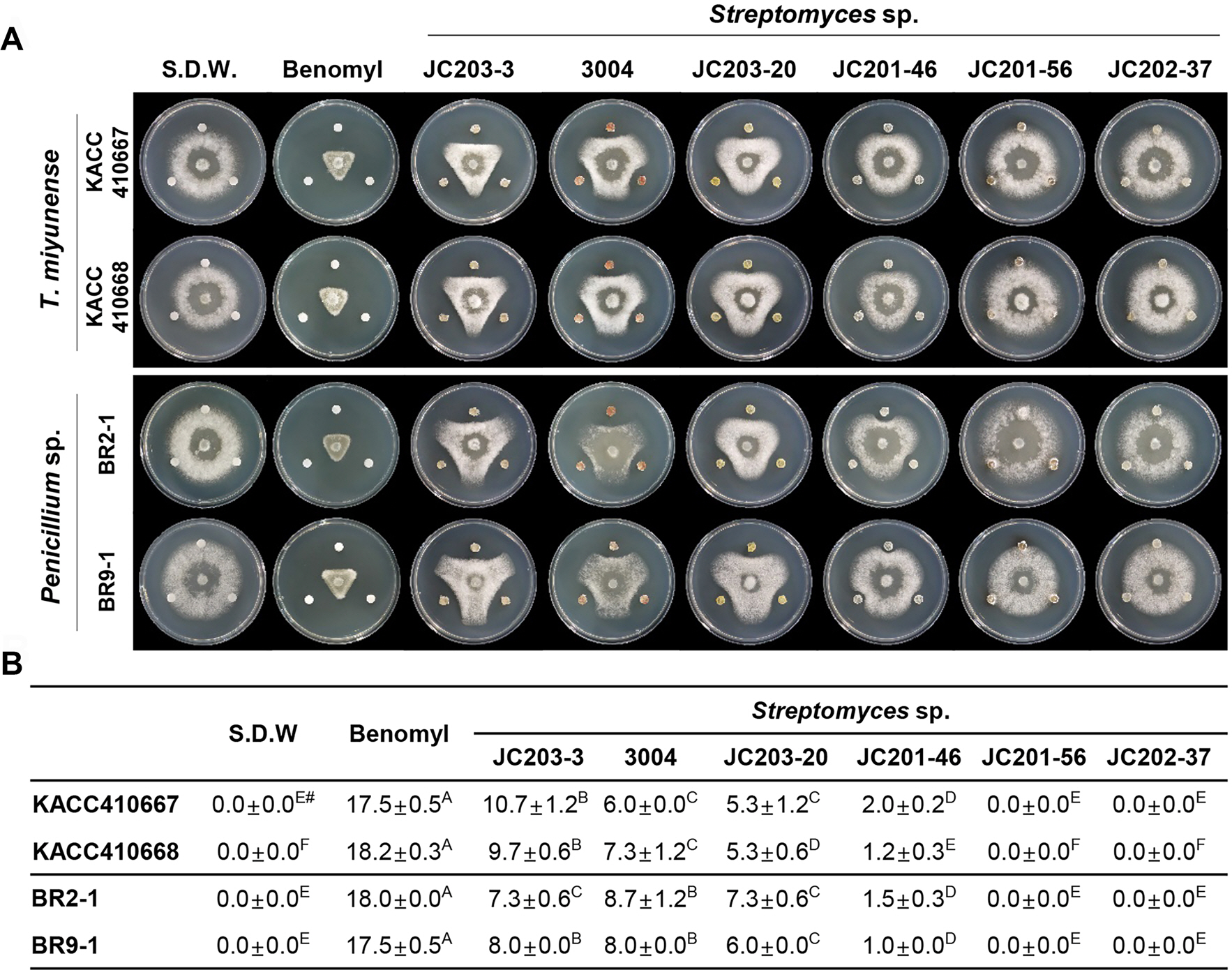Bernaś, E., Jaworska, G. and Lisiewska, Z. 2006. Edible mushrooms as a source of valuable nutritive constituents. Acta. Sci. Pol. Technol. Aliment. 5: 5-20.
Bonaterra, A., Badosa, E., Daranas, N., Francés, J., Roselló, G. and Montesinos, E. 2022. Bacteria as biological control agents of plant diseases.
Microorganisms 10: 1759.



Boukaew, S., Chuenchit, S. and Petcharat, V. 2011. Evaluation of
Streptomyces spp. for biological control of
Sclerotium root and stem rot and
Ralstonia wilt of chili pepper.
Bio. Control. 56: 365-374.


Chamberlain, K. and Crawford, D. L. 1999. In vitro and in vivo antagonism of pathogenic turfgrass fungi by
Streptomyces hygro-scopicus strains YCED9 and WYE53.
J. Ind. Microbiol. Biotechnol. 23: 641-646.


Chen, P. C. and Hou, H. H. 1978. Tremella fuciformis, in the biology and cultivation of edible mushroom. Academic Press, New York, NY, USA. pp. 629 pp.
Chi, M. H., Park, S. Y. and Lee, Y. H. 2009. A quick and safe method for fungal DNA extraction.
Plant Pathol. J. 25: 108-111.

Clemons, G. P. and Sisler, H. D. 1971. Localization of the site of action of a fungitoxic benomyl derivative.
Pestic. Biochem. Physiol. 1: 32-43.

Davidse, L. C. 1973. Antimitotic activity of methyl benzimidazol-2-yl carbamate (MBC) in
Aspergillus nidulans.
Pestic. Biochem. Physiol. 3: 317-325.

Gardes, M. and Bruns, T. D. 1993. ITS primers with enhanced specificity for basidiomycetes-application to the identification of mycorrhizae and rusts.
Mol. Ecol. 2: 113-118.


Gezgin, Y., Güralp, G., Barlas, A. B. and Eltem, R. 2023. Morphological and molecular identification of
Trichoderma isolates used as biocontrol agents by DNA barcoding.
Eur. J. Biol. 82: 59-69.

Hammerschlag, R. S. and Sisler, H. D. 1973. Benomyl and methyl-2-benzimidazolecarbamate (MBC): biochemical, cytological and chemical aspects of toxicity to
Ustilago maydis and
Saccharomyces cerevesiae.
Pestic. Biochem. Physiol. 3: 42-54.

Houbraken, J., Seifert, K. A. and Samson, R. A. 2019.
Penicillium hermansii, a new species causing smoky mould in white button mushroom production.
Mycol. Prog. 18: 229-236.


Kamil, D., Prameela Devi, T., Choudhary, S.P., Das, A. and Kumar, A. 2022. Genome-mediated methods to unravel the native biogeographical diversity and biosynthetic potential of
Trichoderma for plant health. In: Fungal diversity, ecology and control management. Fungal Biology, eds. by V. R. Rajpal, I. Singh and S. S. Navi, pp.109-124. Springer, Singapore


Kim, M. K., Sim, S., Choi, S. L. and Hong, K. P. 2019. Diversity analysis of culture-dependent fungal species isolated from the sawdust media of Lentinula edodes. J. Mushroom. 17: 179-184. (In Korean)
Kim, M. K., Sim, S. A., Kim, A. Y., Kwon, J. H. and Chang, Y. H. 2020. Characterization of green mold contamination caused by Penicillium brevicompactum in Hypsizygus marmoreus. Kor. J. Mycol. 48: 397-405. (In Koean)
Kosanović, D., Potočnik, I., Vukojević, J., Stajić, M., Rekanović, E., Stepanović, M. et al. 2015. Fungicide sensitivity of
Trichoderma spp. from
Agaricus bisporus farms in Serbia.
J. Environ. Sci. Health B. 50: 607-613.


Kubicek, C. P., Steindorff, A. S., Chenthamara, K., Manganiello, G., Henrissat, B., Zhang, J. et al. 2019. Evolution and comparative genomics of the most common
Trichoderma species.
BMC Genomics 20: 485.




Kunova, A., Bonaldi, M., Saracchi, M., Pizzatti, C., Chen, X. and Cortesi, P. 2016. Selection of
Streptomyces against soil borne fungal pathogens by a standardized dual culture assay and evaluation of their effects on seed germination and plant growth.
BMC Microbiol. 16: 272.




Lee, H. J., Yun, Y. B., Huh, J. H. and Kim, Y. K. 2017. Suppression of green mold disease on oak mushroom cultivation by antifungal peptides.
J. Appl. Biol. Chem. 60: 149-153. (In Korean)

Liu, Y. J., Whelen, S. and Hall, B. D. 1999. Phylogenetic relationships among ascomycetes: evidence from an RNA polymerse II subunit.
Mol. Biol. Evol. 16: 1799-1808.


Lu, H., Lou, H., Hu, J., Liu, Z. and Chen, Q. 2020. Macrofungi: a review of cultivation strategies, bioactivity, and application of mushrooms.
Compr. Rev. Food Sci. Food Saf. 19: 2333-2356.



Maheshwary, N. P., Naik, B. G., Chittaragi, A., Naik, M. K., Satish, K. M., Nandish, M. S. et al. 2022. Morpho-molecular characterization, diversity analysis and antagonistic activity of
Trichoderma isolates against predominant soil born pathogens.
Indian Phy-topathol. 75: 1009-1020.


O'Brien, M., Grogan, H. and Kavanagh, K. 2014. Proteomic response of
Trichoderma aggressivum f.
europaeum to
Agaricus bisporus tissue and mushroom compost.
Fungal Biol. 118: 785-791.


O'Brien, M., Kavanagh, K. and Grogan, H. 2017. Detection of
Trichoderma aggressivum in bulk phase III substrate and the effect of
T. aggressivum inoculum, supplementation and substrate-mixing on
Agaricus bisporus yields.
Eur. J. Plant Pathol. 147: 199-209.


Park, M. S., Bae, K. S. and Yu, S. H. 2006. Two new species of
Trichoderma associated with green mold of oyster mushroom cultivation in Korea.
Mycobiology 34: 111-113.



Radványi, D., Gere, A., Sipos, L., Kovács, S., Jókai, Z. and Fodor, P. 2016. Discrimination of mushroom disease-related mould species based solely on unprocessed chromatograms.
J. Chemom. 30: 197-202.

Rangel-Vargas, E., Rodriguez, J. A., Domínguez, R., Lorenzo, J. M., Sosa, M. E., Andrés, S. C. et al. 2021. Edible mushrooms as a natural source of food ingredient/additive replacer.
Foods 10: 2687.



Šašić Zorić, L., Janjušević, L., Djisalov, M., Knežić, T., Vunduk, J., Milenković, I. et al. 2023. Molecular approaches for detection of
Trichoderma green mold disease in edible mushroom production.
Biology 12: 299.



Trejo-Estrada, S. R., Sepulveda, I. R. and Crawford, D. L. 1998. In vitro and in vivo antagonism of Streptomyces violaceusniger YCED9 against fungal pathogens of turfgrass. World J. Microbiol. Biotechnol. 14: 865-872.
Tu, C. and Wu, K. 1989. Properties of Jew's ear (Auricularia spp.) and silver ear (Tremella fuciformis) in Taiwan. Taiwan Agricultural Research Institute, Taichung, Taiwan.
Visagie, C. M., Houbraken, J., Frisvad, J. C., Hong, S. B., Klaassen, C. H., Perrone, G. et al. 2014. Identification and nomenclature of the genus
Penicillium.
Stud. Mycol. 78: 343-371.



White, T. J., Bruns, T., Lee, S. J. W. T. and Taylor, J. 1990. Amplification and direct sequencing of fungal ribosomal RNA genes for phylogenetics. PCR Proto cols: A Guide to Methods and Applications,. M. A. Innis, D. H. Gelfand, J. J. Sninsky and T. J. White 315-322. Academic Press; New York, NY, USA.










 PDF Links
PDF Links PubReader
PubReader ePub Link
ePub Link Full text via DOI
Full text via DOI Download Citation
Download Citation Print
Print






